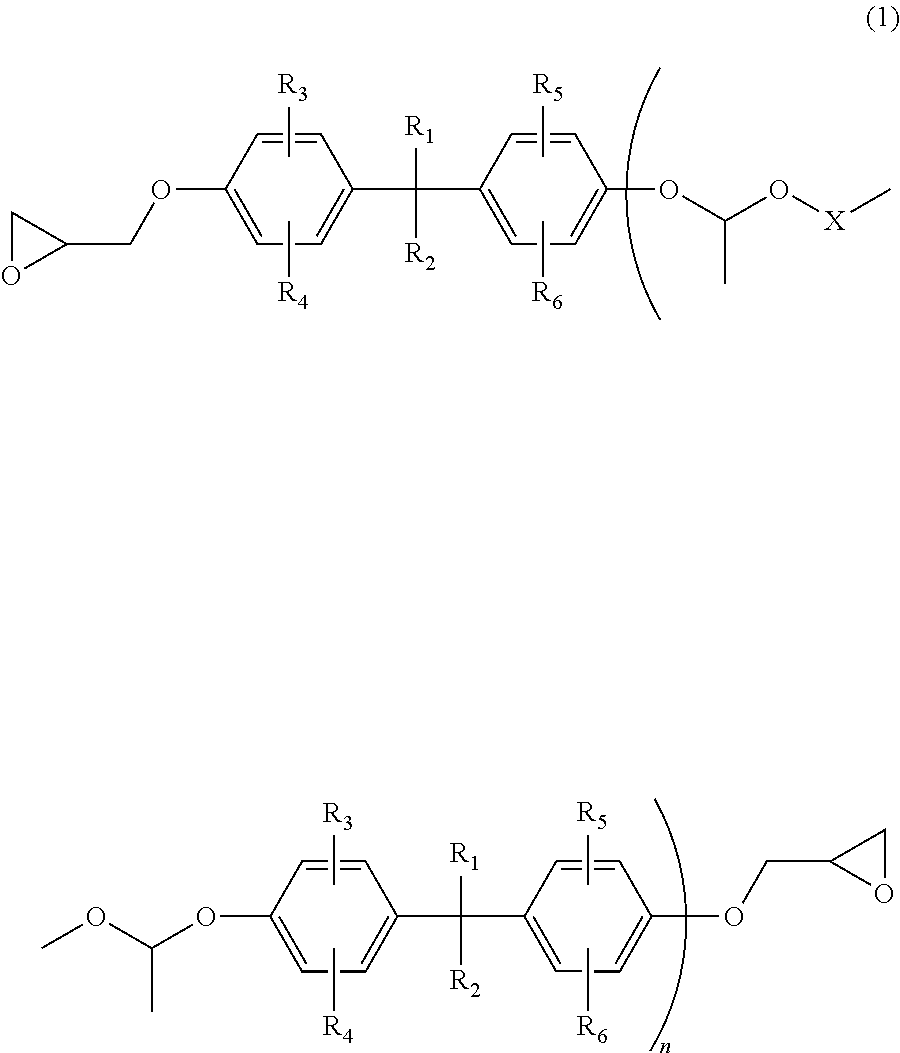Optical waveguide forming epoxy resin composition, curable film formed from the epoxy resin composition for formation of optical waveguide, and light transmission flexible printed board
a technology of epoxy resin and optical waveguide, which is applied in the direction of photosensitive materials, instruments, photomechanical equipment, etc., can solve the problems of adversely affecting the loss of optical waveguide, reducing the flexibility of material design, and affecting the effect of resource saving and cost saving
- Summary
- Abstract
- Description
- Claims
- Application Information
AI Technical Summary
Benefits of technology
Problems solved by technology
Method used
Image
Examples
##ventive example 1
Inventive Example 1
[0051]Prior to production of an optical waveguide according to this example, photosensitive varnishes were prepared as a cladding layer forming material and a core layer forming material.
[0052]Under shaded conditions, 50 g of a liquid long-chain bi-functional semi-aliphatic epoxy resin (EXA-4816 available from DIC Corporation), 20 g of a solid multi-functional aliphatic epoxy resin (EHPE 3150 available from Daicel Chemical Industries Ltd.), 30 g of a liquid long-chain bi-functional aliphatic epoxy resin (PG-207N available from Nippon Steel Chemical Co., Ltd.) and 2.0 g of a photoacid generator (ADEKAOPTOMER SP-170 available from Adeka Corporation) were mixed with 20 g of ethyl lactate, and completely dissolved in ethyl lactate at 85° C. with heating. Then, the resulting mixture was cooled to a room temperature (25° C.), and then filtered under higher temperature and higher pressure conditions with the use of a membrane filter having a pore diameter of 1.0 μm. Thus...
##ventive example 2
Inventive Example 2
[0059]An optical waveguide was produced in substantially the same manner as in Inventive Example 1, except that, in the preparation of the photosensitive varnish as the cladding layer forming material, the formulation of the resin component was changed to include 60 g of the liquid long-chain bi-functional semi-aliphatic epoxy resin (EXA-4816 available from DIC Corporation), 20 g of the solid multi-functional aliphatic epoxy resin (EHPE 3150 available from Daicel Chemical Industries Ltd.) and 20 g of the liquid long-chain bi-functional aliphatic epoxy resin (PG-207N available from Nippon Steel Chemical Co., Ltd.)
##ventive example 3
Inventive Example 3
[0060]An optical waveguide was produced in substantially the same manner as in Inventive Example 1, except that, in the preparation of the photosensitive varnish as the cladding layer forming material, the formulation of the resin component was changed to include 70 g of the liquid long-chain bi-functional semi-aliphatic epoxy resin (EXA-4816 available from DIC Corporation), 20 g of the solid multi-functional aliphatic epoxy resin (EHPE 3150 available from Daicel Chemical Industries Ltd.) and 10 g of the liquid long-chain bi-functional aliphatic epoxy resin (PG-207N available from Nippon Steel Chemical Co., Ltd.)
PUM
| Property | Measurement | Unit |
|---|---|---|
| temperature | aaaaa | aaaaa |
| Tg | aaaaa | aaaaa |
| Tg | aaaaa | aaaaa |
Abstract
Description
Claims
Application Information
 Login to View More
Login to View More - R&D
- Intellectual Property
- Life Sciences
- Materials
- Tech Scout
- Unparalleled Data Quality
- Higher Quality Content
- 60% Fewer Hallucinations
Browse by: Latest US Patents, China's latest patents, Technical Efficacy Thesaurus, Application Domain, Technology Topic, Popular Technical Reports.
© 2025 PatSnap. All rights reserved.Legal|Privacy policy|Modern Slavery Act Transparency Statement|Sitemap|About US| Contact US: help@patsnap.com



